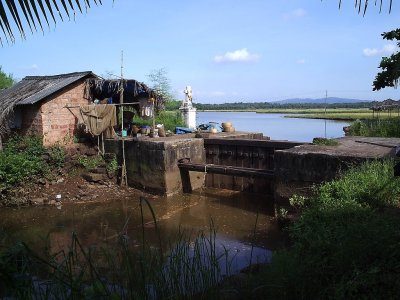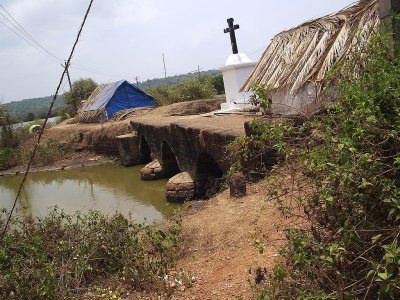The Hindi word ‘khazana‘, means treasure. All over Goa, there is an intricate system of water dukes, sluice gates, bunds, furrows and canals that date back to the B.C (before Christ) era. These ecosystems are called the Khazan Ecosystem of Goa. They are truly an ecological treasure (an ecological Khazana).
What exactly is a Khazan?
A Khazan is a marvel of tribal engineering. It probably originated among the prehistoric Gauda Tribes of Goa. They had a fantastic working knowledge of the rhythm of the monsoons and the flow of water during the tides. They also knew how to build bunds, dikes, canals, and sluice gates to control the flow of this water. As a result of this primitive but highly effective technology, they were able to reclaim vast tracts of mangrove forests, and other coastal lands and put that land to other uses. Growing paddy, cultivating prawns, and panning salt, were the three main uses for the Khazan lands.
Their knowledge of the flow of water and their ability to control that flow was truly impressive. Especially when you keep in mind that they created such systems almost 3500 years ago. With simple primitive technology. They usually picked an agriculture field near the waterfront, along with an inner small embankment. To this area, they built protective dikes ( the inner dikes are called mero, the thick outer dikes are called bunds) and sluice gates, which were opened and closed at specific times to control the flow of water. There is also a shallow pit called a ‘poiem’ and a water channel to circulate water into the fields. Most of these were made by hand with rudimentary materials such as mud, clay, and straw.




Pic credits: Khazan Ecosystems of Goa
The outer, thick dikes are designed specially to withstand the high pressure of the estuarine water flow, and the pressure from the tides. A furrow is then dug between the two protective walls of the dikes. This furrow is called a ‘chanoy‘. To hold the furrow firmly in place they make a special clay from the mud of the fields that is almost like glue. They call it ‘tharcupto.’ Making a tharcupto takes a special engineering skill. There are two steps involved – the making of the ‘thar’ and the making of the ‘cupto.’
To make the ‘thar’ they use a layer of material made out of a mixture of paddy and straw. The next step is to make the ‘cupto.’ To do this, a layer of smooth alluvial mud is used. It is spread over the ‘thar’ layer by hand and punched and packed into place. This keeps it firmly intact and in place.
The flow of water to and from the dikes is controlled by sluice gates called ‘Manos’. These sluice gates have wooden shutters that are designed to open and close automatically with the change in tides. The wood used is the wood of the ‘Matti’ tree (this is the state tree of Goa. It can resist wood borers for up to 3 years).
Khazan lands are used to grow paddy and coconut trees. The slightly saline water is perfect for cultivating coconuts. The irrigation is just right for paddy cultivation.
Prawns and small fish are also hatched here. The fishermen fish these waters in a small canoe called a ‘ponel.’ They use a variety of nets such as bag nets called ‘manxeche jale’ gill nets called ‘katalin’ and cast nets called ‘pagyer.’ They also catch crabs with a special method called ‘deepkavani’ (this method involved blinding the crabs with a strong source of light.
Besides prawns, mullet, catfish (Sangat) and sardines are also bred in these waters. These waters are also panned for salt. The salt pans are carefully prepared by draining large tracts of this kind of Khazan land. Then, through an intricate system of irrigation, the saline water is let into each carefully prepared salt pan, and the salt is made by the simple process of evaporation by sunlight.
Goa has vast tracts of such Khazan lands. You can see them as you drive down the roads that run along the coastal areas, past the mangroves. Some popular spots are along the Chapora river, as it flows past Siolim, Kudal, Oxel, and Camurlim. Ribandar, Chorao and Divar islands also have Khazan lands. As you drive to Goa’s airport, look out of your window. At the Cortalim bridge and all along the road to Dabolim, you will see Khazans on both sides. Sometimes a crocodile slips through the sluice gates and lands up in the salt pans.
Information sources: Khazan Ecosystems of Goa and mundusmaris.org


